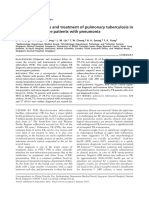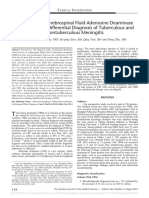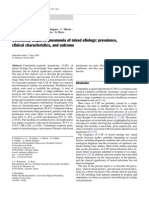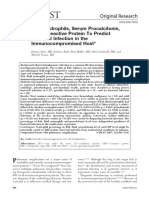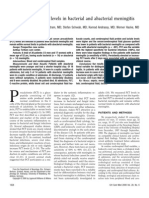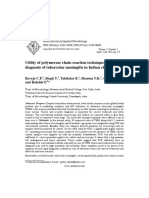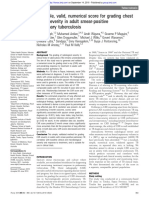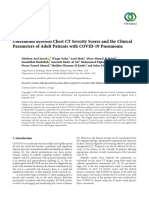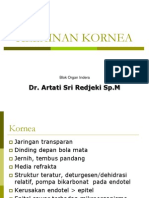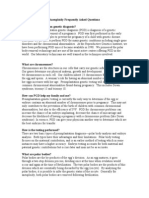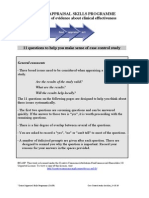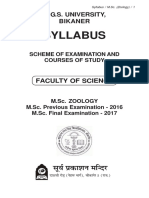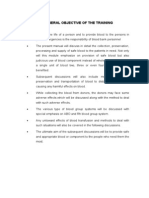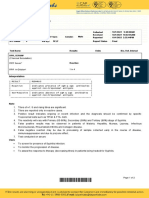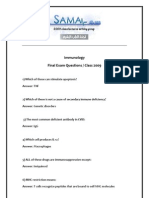0 ratings0% found this document useful (0 votes)
30 viewsDiagnostic Potential Of 16 Kda (Hspx, Α-Crystalline) Antigen For Serodiagnosis Of Tuberculosis
Diagnostic Potential Of 16 Kda (Hspx, Α-Crystalline) Antigen For Serodiagnosis Of Tuberculosis
Uploaded by
pouralThis document discusses a study that evaluated the diagnostic potential of the 16 kDa antigen for serodiagnosis of tuberculosis. The study assessed humoral immune responses to the 16 kDa antigen in serum samples from 200 pulmonary tuberculosis patients, 30 patients with tuberculous pleural effusion, 21 patients with tuberculous meningitis, and controls using ELISA. The sensitivity for detecting pulmonary TB ranged from 73.8-81.2% and was lower for extrapulmonary TB at 42.8% for tuberculous meningitis and 63.3% for tuberculous pleural effusion. The antigen showed encouraging results for diagnosing pulmonary TB but more limited utility for extrapulmonary
Copyright:
Attribution Non-Commercial (BY-NC)
Available Formats
Download as PDF, TXT or read online from Scribd
Diagnostic Potential Of 16 Kda (Hspx, Α-Crystalline) Antigen For Serodiagnosis Of Tuberculosis
Diagnostic Potential Of 16 Kda (Hspx, Α-Crystalline) Antigen For Serodiagnosis Of Tuberculosis
Uploaded by
poural0 ratings0% found this document useful (0 votes)
30 views7 pagesThis document discusses a study that evaluated the diagnostic potential of the 16 kDa antigen for serodiagnosis of tuberculosis. The study assessed humoral immune responses to the 16 kDa antigen in serum samples from 200 pulmonary tuberculosis patients, 30 patients with tuberculous pleural effusion, 21 patients with tuberculous meningitis, and controls using ELISA. The sensitivity for detecting pulmonary TB ranged from 73.8-81.2% and was lower for extrapulmonary TB at 42.8% for tuberculous meningitis and 63.3% for tuberculous pleural effusion. The antigen showed encouraging results for diagnosing pulmonary TB but more limited utility for extrapulmonary
Original Title
IndianJMedRes1355771-5765198_160051
Copyright
© Attribution Non-Commercial (BY-NC)
Available Formats
PDF, TXT or read online from Scribd
Share this document
Did you find this document useful?
Is this content inappropriate?
This document discusses a study that evaluated the diagnostic potential of the 16 kDa antigen for serodiagnosis of tuberculosis. The study assessed humoral immune responses to the 16 kDa antigen in serum samples from 200 pulmonary tuberculosis patients, 30 patients with tuberculous pleural effusion, 21 patients with tuberculous meningitis, and controls using ELISA. The sensitivity for detecting pulmonary TB ranged from 73.8-81.2% and was lower for extrapulmonary TB at 42.8% for tuberculous meningitis and 63.3% for tuberculous pleural effusion. The antigen showed encouraging results for diagnosing pulmonary TB but more limited utility for extrapulmonary
Copyright:
Attribution Non-Commercial (BY-NC)
Available Formats
Download as PDF, TXT or read online from Scribd
Download as pdf or txt
0 ratings0% found this document useful (0 votes)
30 views7 pagesDiagnostic Potential Of 16 Kda (Hspx, Α-Crystalline) Antigen For Serodiagnosis Of Tuberculosis
Diagnostic Potential Of 16 Kda (Hspx, Α-Crystalline) Antigen For Serodiagnosis Of Tuberculosis
Uploaded by
pouralThis document discusses a study that evaluated the diagnostic potential of the 16 kDa antigen for serodiagnosis of tuberculosis. The study assessed humoral immune responses to the 16 kDa antigen in serum samples from 200 pulmonary tuberculosis patients, 30 patients with tuberculous pleural effusion, 21 patients with tuberculous meningitis, and controls using ELISA. The sensitivity for detecting pulmonary TB ranged from 73.8-81.2% and was lower for extrapulmonary TB at 42.8% for tuberculous meningitis and 63.3% for tuberculous pleural effusion. The antigen showed encouraging results for diagnosing pulmonary TB but more limited utility for extrapulmonary
Copyright:
Attribution Non-Commercial (BY-NC)
Available Formats
Download as PDF, TXT or read online from Scribd
Download as pdf or txt
You are on page 1of 7
Diagnostic potential of 16 kDa (HspX, -crystalline) antigen
for serodiagnosis of tuberculosis
Amit Kaushik, Urvashi B. Singh, Chhavi Porwal, Shwetha J. Venugopal, Anant Mohan
*
,
Anand Krishnan
**
, Vinay Goyal
+
& Jayant N. Banavaliker
++
Departments of Microbiology,
*
Medicine,
+
Neurology &
**
Centre for Community Medicine,
All India Institute of Medical Sciences, New Delhi &
++
Rajan Babu Institute for
Pulmonary Medicine & Tuberculosis, Delhi, India
Received March 8, 2011
Background & objectives: Tuberculosis (TB) is a public health problem worldwide. Rapid and accurate
diagnosis of tuberculosis is crucial to facilitate early treatment of infectious cases and to reduce its spread.
The present study was aimed to evaluation of 16 kDa antigen as a serodiagnostic tool in pulmonary and
extra-pulmonary tuberculosis patients in an effort to improve diagnostic algorithm for tuberculosis.
Methods: In this study, 200 serum samples were collected from smear positive and culture confrmed
pulmonary tuberculosis patients, 30 tubercular pleural effusions and 21 tubercular meningitis (TBM)
patients. Serum samples from 36 healthy, age matched controls (hospital staff), along with 60 patients
with non-tubercular respiratory diseases were also collected and evaluated. Humoral response (both IgG
and IgA) was looked for 16 kDa antigen using indirect ELISA.
Results: Sensitivity of detection in varies categories of pulmonary TB patients ranged between 73.8 and
81.2 per cent. While in the extra-pulmonary TB samples the sensitivity was 42.8 per cent (TBM) and 63.3
per cent (tubercular pleural effusion). The test specifcity in both the groups was high (94.7%). All of the
non-disease controls were negative. Among non-tubercular disease controls, fve patients gave a positive
humoral response against 16 kDa.
Interpretation & conclusions: Serodiagnostic tests for TB have always had drawbacks of suboptimal
sensitivity and specifcity. The antigen used in this study gave encouraging results in pulmonary TB only,
while in extra-pulmonary TB (tubercular meningitis and tubercular pleural effusion), this has shown a
limited role in terms of sensitivity. Further work is required to validate its role in serodiagnosis of TB
especially extra-pulmonary TB.
Key words ELISA - EPTB - serodiagnosis - tuberculosis - 16 kDa
Tuberculosis (TB) is a major public health problem
worldwide and was responsible for 8.8 million incident
cases of TB and 1.45 million deaths in the year 2010
1
.
The failure to diagnose TB accurately and rapidly is
a key challenge in curbing the epidemic
2,3
. Rapid and
accurate diagnosis of tuberculosis is crucial to facilitate
early treatment of infectious cases and thus to reduce
its spread.
Indian J Med Res 135, May 2012, pp 771-777
771
[Downloadedfreefromhttp://www.ijmr.org.inonTuesday,January15,2013,IP:114.79.28.4]||ClickheretodownloadfreeAndroidapplicationforthisjournal
TB diagnosis largely depends upon clinical
examination and radiographic fndings, mainly
confrmed by sputum smear microscopy and bacterial
culture
3
. Many alternative methodologies have been
applied in TB diagnosis, such as PCR and cell-mediated
immune response reactions
4
. These methods require
trained personnel and specifc laboratory conditions,
which hinder their implementation in many areas of
high TB endemicity.
Extra-pulmonary TB (EPTB) remains an important
diagnostic and therapeutic problem. The diagnosis of
extra-pulmonary tuberculosis is challenging due to
the paucibacillary nature of the specimens, inability to
access the site of disease activity, the lack of adequate
sample volumes and the presence of inhibitors
that undermine the performance of nucleic acid
amplifcation-based techniques. Serological tests may
prove useful with the advantages of speed, technical
simplicity, possible adaptation towards point-of-care
formats and low cost
5,6
.
The availability of numerous well characterized
M. tuberculosis proteins has revived interest in the
serological diagnosis of tuberculosis. Several promising
antigens have been reported such as 16 kDa, 45 kDa,
antigen 85 complex (30 kDa), 65 kDa Hsp, 88 kDa, 38
kDa, ESAT-6, CFP-10, etc
8
. Antibody response to the
38 kDa in pulmonary TB has been extensively studied,
and there are a few reports about the utility of the 16
kDa-based serological tests in pulmonary and extra-
pulmonary TB
7-9
.
The aim of the present study was to explore the
serodiagnostic potential of 16 kDa (HspX, Rv2031c, or
-crystalline) antigen in different groups of tuberculosis
patients. 16 kDa is an immunodominant antigen that
is recognized by the majority of patients with active
tuberculosis
10
. Production of Rv2031c appears to
increase as the bacteria go into the metabolically
resting stage and decreases as they revert to exponential
growth
11
, thus providing a constant source of antigen in
cultures and possibly in vivo.
Material & Methods
A total of 347 subjects (age range= 18 to 65 yr,
male= 235, female= 112) were recruited between June
2007 to July 2010 (Table I). All patients and control
subjects gave informed consent prior to sampling.
The cross-sectional study protocol was reviewed and
approved by the ethics committee of the All India
Institute of Medical Sciences (AIIMS), New Delhi.
Detailed clinical history and fndings were recorded in
a case record form.
A total of 200 pulmonary TB (PTB) patients
were enrolled prospectively from Comprehensive
Rural Health Services Project (CRHSP), Centre for
Community Medicine, Ballabgarh, Haryana (n=120)
and Rajan Babu Institute for Pulmonary Medicine &
Tuberculosis (RBIPMT), New Delhi (n=80); and were
classifed 78 category I PTB patients (new sputum
smear positive), 42 category II PTB patients (sputum
smear positive after default or relapse/treatment failure)
and 80 multi-drug resistant PTB patients.
Sputum (5-10 ml) and blood samples (2-3 ml)
were collected within two weeks of initiation of anti-
tuberculosis treatment (ATT) from category I and
category II patients (from CRHSP). MDR PTB patients
admitted at RBIPMT were on ATT at the time of inclusion
in the study. All the patients included in the study had
the sputum culture positive for M. tuberculosis. After
collection, samples were transported in cold chain.
Twenty one in-patients with tuberculous meningitis
(TBM) were enrolled from the Department of Neurology,
AIIMS, New Delhi. Sixteen patients were clinically
and radiologically confrmed
12
and cerebrospinal fuid
(CSF) of fve patients grew M. tuberculosis on culture.
Blood sample (2-3 ml) was collected within two weeks
of initiation of ATT.
Thirty patients with tubercular pleural effusion were
enrolled from CRHSP, Ballabgarh, Haryana and AIIMS,
New Delhi. Patients were clinically and radiologically
confrmed as the microbiological confrmation could
not be obtained for all patients. A total of 60 subjects,
who were suffering from respiratory/lung diseases
(other than tuberculosis) were included as disease
controls from AIIMS, New Delhi. Lung cancer (n=21),
asthma (n=9), pneumonia (n=7), chronic obstructive
pulmonary disorder (n=5), interstitial lung disease (n=3),
sarcoidosis (n=3), respiratory distress (n=3), allergic
broncho pulmonary aspergillosis (n=3), bronchiectasis
(n=2), occupational lung disease (n=1), Wegeners
granulomatosis (n=1), bronchiolitis obliterans (n=1),
metabolic encephalopathy (n=1) formed the spectrum.
Sputum/induced sputum samples were obtained. All
above disease controls were evaluated bacteriologically
for M. tuberculosis using culture and AFB smear and
found negative. Forty six subjects had M. bovis BCG
vaccination history. The purifed protein derivative
(PPD) status of the patients was unknown.
772 INDIAN J MED RES, MAY 2012
[Downloadedfreefromhttp://www.ijmr.org.inonTuesday,January15,2013,IP:114.79.28.4]||ClickheretodownloadfreeAndroidapplicationforthisjournal
Thirty six healthy individuals (with no known
history of active TB) were enrolled from the staff
working in Department of Microbiology, AIIMS, New
Delhi, as healthy controls or non-disease controls.
All these were healthy with no apparent signs of any
disease. All of them had BCG vaccination history. The
purifed protein derivative (PPD) status of the subjects
was not known.
Sample processing: Sputum samples were processed
using standard NALC-NaOH method
13
and smears
were examined after ZiehlNeelsen staining. Processed
samples were inoculated in MGIT (Mycobacterial
growth indicator tube) 960 non-radiometric automated
isolation system (BD, USA). MGIT tube was
supplemented with 0.5 ml of oleic acid-albumin-
dextrose-catalase along with mixture of 5 antibiotics
(PANTA i.e., polymyxin B, amphotericin B, nalidixic
acid, trimethoprim and azlocillin) and 0.5 ml of
decontaminated sample. M. tuberculosis complex and
non-tuberculous mycobacteria were differentiated using
p-nitrobenzoic acid (PNBA) test (as recommended in
MGIT-960 protocol). Drug susceptibility testing (DST)
was performed using 1 per cent proportion method
using above automated culture system to reassure the
MDR status (as recommended in MGIT-960 protocol).
Serum samples were separated and immediately stored
in -80C till further use.
ELISA protocol: ELISA was performed with some
modifcations
14,15
to estimate the humoral responses
(IgG and IgA, in the same well) against native 16 kDa
antigen. Briefy, the 96-well microtiter plates (Maxisorp
Nunc, Denmark) were coated with native antigen in
PBS (50 l/well of 5 g/ml) overnight at 4C. Next day,
plates were washed three times with PBS-T, blocked
with 1 per cent BSA in PBS-T (blocking buffer) for
two hours at 37C and followed by three washings.
Subsequently, 100 l of diluted sera (1:100 in 0.1 x
blocking buffer) from patients and healthy subjects was
added and the plates were incubated for 90 min at 37C.
After six washes with PBS-Tween 20 (0.05% Tween 20
in PBS), a mixture of alkaline phosphatase-conjugated
protein A (1:2,000) and anti-human immunoglobulin A
(IgA; 1:1,000) (Sigma-Aldrich, St. Louis, USA) was
added to each well and the plates were incubated for
1 h at 37C. The wells were washed six times with
PBS-T, and the bound enzyme-conjugated antibodies
were detected with p-nitrophenylphosphate substrate
(Sigma, USA), (1 mg/ml p-nitrophenylphosphate in
10% diethanolamine buffer containing 0.5 mM MgCl
2
,
pH 9.8). The plates were read at 405 nm in ELISA plate
reader (Microscan, ECIL, India).
Data analysis: The cut-off was determined by
calculating the mean optical density (OD) obtained
with sera from healthy individuals plus 3 standard
KAUSHIK et al: 16 KDA ANTIGEN IN TB DIAGNOSIS 773
Table I. Details/profle of subjects (n=347) enrolled in study
Sr.
no.
Subjects Total no. Male/
female
Mean age
(yr) SD
Inclusion criteria Positive for 16 kDa
antigen
1. Category I
pulmonary TB
78 54/24 31.1 11.9 Culture confrmed for
M. tuberculosis
63
2. Category II
pulmonary TB
42 30/12 35.5 12.4 Culture confrmed for
M. tuberculosis
31
3. MDR pulmonary
TB
80 47/33 33.2 9.8 Culture confrmed for
M. tuberculosis,
Sensitivity confrmed
MDR-TB
65
4. Tuberculous
meningitis (TBM)
21 13/8 34.3 14.6 Clinically & radiologically
confrmed (fve samples
bacteriologically confrmed)
9
5. Tubercular pleural
effusion
30 21/9 37.3 14.9 Clinically & radiologically
confrmed
19
6. Non-disease
controls
36 27/9 31.2 6.9 Healthy individuals with no
apparent signs for any disease
0
7. Disease controls
(non-tubercular)
60 43/17 45 13.1 Disease confrmed 5
*
*One each of lung cancer, pneumonia, ILD, sarcoidosis, respiratory distress
[Downloadedfreefromhttp://www.ijmr.org.inonTuesday,January15,2013,IP:114.79.28.4]||ClickheretodownloadfreeAndroidapplicationforthisjournal
deviations (SD). Each assay was repeated three times.
Two or three positives out of three ELISAs were
considered as positive. Sensitivity and specifcity were
calculated by standard methods. Scatter plot and ROC
(receiver operative characteristic) curves were plotted
using GraphPad Prism software, version 5, USA. ROC
curve describes probabilities of correct and incorrect
results at different cut-off values. The area under ROC
curve refects the accuracy of a test
16
.
Results
The 347 subjects when grouped into different
categories, 78 were in category I PTB, 42 were
in category II PTB, 80 were MDR PTB, 21 were
tubercular meningitis, 30 were pleural effusion, 36
were non-disease controls and 60 were disease controls
(other than tuberculosis) (Table I).
Fig. 1 shows the scatter plot of antibody response
in different groups of patients and controls. Each
dot represents the O.D. (O.D.= O.D. of sample -
cut-off value) for individual patient. All dots above
X-axis were positive O.Ds. Fig. 2 A and B shows the
receiver operative characteristic (ROC) curve for PTB
(category I PTB, category II PTB and MDR) and extra-
pulmonary TB (tuberculous meningitis and tubercular
pleural effusion), respectively with 16 kDa antigen.
16 kDa antigen was used for detection of humoral
responses (IgG and IgA) in these subjects using
ELISA and sensitivity, specifcity and other parameters
were predicted (Table II). The diagnostic sensitivity
of 16 kDa antigen with category I PTB, category
II PTB and MDR PTB was found to be 80.7, 73.8
and 81.2 per cent, respectively. The sensitivity was
found to be comparatively lower in category II PTB
than the category I PTB and MDR PTB. While in
the extra-pulmonary TB i.e. tuberculosis meningitis
and tubercular pleural effusion cases, the diagnostic
sensitivity was 42.8 and 63.3 per cent, respectively.
Specifcity was high (>94%) in PTB as well as extra-
pulmonary tuberculosis groups (Table II).
None of the non-disease controls was positive for
antibodies to 16 kDa, however, fve disease controls
were found to be positive. These patients were being
treated for lung cancer (1), sarcoidosis (1), interstitial
Table II. Sensitivity, specifcity and likehood ratios of 16 kDa antigen ELISA for antibody detection
Characteristic Category I
PTB
(n=78)
Category II
PTB
(n=42)
MDR
PTB
(n=80)
Tuberculous
meningitis
(n=21)
Tubercular pleural
effusion
(n=30)
Sensitivity (%),
95% confdence interval (%)
80.7
(69.9 to 88.4)
73.8
(57.6 to 85.6)
81.2
(70 to 88.7)
42.8
(22.5 to 65.5)
63.3
(43.9 to 79.4)
Specifcity (%),
95% confdence interval (%)
94.7
(87.7 to 98)
94.7
(87.7 to 98)
94.7
(87.7 to 98)
94.7
(87.7 to 98)
94.7
(87.7 to 98)
Likelihood ratio for positive test
result (LR+)
15.5 14.2 15.6 8.2 12.2
Likelihood ratio for negative
test result (LR-)
0.20 0.27 0.19 0.60 0.38
Fig. 1. (I) Scatter plot of humoral responses in serum samples
of non-disease controls, disease controls, category I PTB, category
II PTB, MDR-TB, tuberculous meningitis (TBM) and tubercular
pleural effusion patients. Each dot represents the O.D. (O.D.
= O.D. of sample cut-off value) for individual patient. All dots
above X-axis are positive O.Ds. All dots below X-axis are negative
O.Ds.
774 INDIAN J MED RES, MAY 2012
[Downloadedfreefromhttp://www.ijmr.org.inonTuesday,January15,2013,IP:114.79.28.4]||ClickheretodownloadfreeAndroidapplicationforthisjournal
lung disease (ILD 1), pneumonia (1) and respiratory
distress (1).
Discussion
In the present study, we evaluated the 16 kDa
antigen, in PTB and EPTB (TBM and tubercular pleural
effusion) patients, and compared the antibody assay
with other diagnostic modalities. In our study, none of
the non-disease controls was positive for antibodies to
16 kDa. In a TB endemic country like India a majority
of the population is likely to be latently infected
or BCG-vaccinated; the absence of any humoral
response against mycobacteria gives credence to high
specifcity of the antigen for detecting active disease.
Geluk et al
17
have shown most M. tuberculosis infected
or exposed individuals responded well to HspX,
whereas signifcantly lower responses were observed
in unexposed individuals, including BCG-vaccinated
individuals. Rabahi et al
18
have shown higher HspX
in the M. tuberculosis exposed individual and good
indicator for new infection. Davidow et al
19
found
higher humoral response among inactive TB than the
active TB.
A meta-analysis performed by Steingart et al
20
has
reported high specifcity for detection of pulmonary
tuberculosis (86 to 100%), using the commercially
available pathozyme TB complex plus (ELISA
based antibody detection, utilizes the recombinant 38
kDa and 16 kDa) in various studies
21-23
. Another study
has shown 98 per cent specifcity in a large number
of Polish population
24
using the above test. Raja
et al
25
have shown a specifcity of 94 per cent using
16 kDa antigen for antibody detection in pulmonary
tuberculosis patients and controls including non-
tuberculous lung disease and healthy subjects.
Several antigens have been shown to have strong
immunodiagnostic potential. A couple of studies are
available for the 16 kDa molecule, a polypeptide
belonging to the -crystallin family of low molecular
weight heat shock proteins. The coding gene (Rv2031c)
for this antigen has been found exclusively in the M.
tuberculosis complex as shown by DNA hybridization
studies
26
. It has been reported as a dominant protein,
produced in the static growth phase or under oxygen
deprivation and is essential for bacterial replication
inside macrophages
11
.
In non-tubercular disease controls, fve of 60
controls gave the non-specifc positive humoral
response. Though sputum/induced sputum were
obtained from above disease control group, all were
negative for AFB smear microscopy and MGIT-960
rapid culture. All the care had been employed at the
time of enrollment of above disease controls to rule
out history of active TB. An earlier study
26
has shown
that antibodies against 16 kDa do not cross-react
with common environmental mycobacteria. Julian et
al
21
have shown some non-specifcity in pneumonia
Fig. 2. Receiver operative characteristic (ROC) curve for (A): PTB (category I PTB, category II PTB and MDR). Area
under ROC curve 0.9083, 95% CI (confdence interval) 0.8739 to 0.9428, Std. error 0.01758, P<0.001. Small bars on
the ROC curve showing the cut-offs. (B): EPTB (tuberculous meningitis and tubercular pleural effusion) area under ROC
curve: 0.7571, 95% CI 0.6589 to 0.8554, Std. error 0.05013, P<0.001.
KAUSHIK et al: 16 KDA ANTIGEN IN TB DIAGNOSIS 775
[Downloadedfreefromhttp://www.ijmr.org.inonTuesday,January15,2013,IP:114.79.28.4]||ClickheretodownloadfreeAndroidapplicationforthisjournal
population using 16 kDa antibody detection,
antibodies to 16 kDa have been shown among non-
TB lung diseases such as asthma, lung cancer
25
. The
loss of specifcity may be due to latent infection or to
nonspecifc hyperglobulinaemia, common in bronchial
diseases
27
.
Our results have shown a signifcant (P<0.05)
higher antibody response in PTB than EPTB for 16
kDa antigen. Many of the serological studies have
been reported from patients with extensive pulmonary
disease
24,28
. The group that would most beneft from
serological tests is the one with smear negative or extra-
pulmonary TB. In this group of patients, the sensitivity
of different assays was reported to be signifcantly
lower than in the confrmed cases
9,24,29
. The extensive
extra-cellular bacterial replication in cavities and the
continued shedding of antigens is possibly enhanced in
the pulmonary cavitary environment. The paucibacillary
and often walled off EPTB lesions
30
may be different
in producing lesser amount of antigen and hence may
take longer to generate an antibody response. The study
patients were sampled within a few days of the clinical
diagnosis and hence may not have shown an adequate
serological response.
The sensitivity was much higher in category I,
category II PTB and MDR PTB patients. Repeated
immune stimulation by mycobacterial antigens
and higher antigenic load because of multiplying
mycobacteria in MDR-PTB and category II PTB may
explain this.
Serodiagnostic tests for tuberculosis have never
been very successful due to suboptimal sensitivity and
specifcity. To discourage the rampant use of commercial
TB serodiagnostics tests, WHO has issued a policy note
discouraging the use of current serodiagnostics tests
31
.
The present study has limitations such as the
serologic tests were performed retrospectively; using
serum that had been stored at -80
o
C, although no serum
had been thawed more than once. The total number
of EPTB (TBM and tubercular pleural effusion)
subjects enrolled in the study was small. The results
in our study were encouraging only in PTB group;
and in tuberculous meningitis and tubercular pleural
effusion patients were not up to expectations. The use
of additional antigen(s) combinations or epitopes need
to be evaluated for serodiagnosis.
Acknowledgment
The frst and third authors (AK, CP) acknowledge the research
fellowships from the Council of Scientifc and Industrial Research
(CSIR) and Indian Council of Medical Research (ICMR), New
Delhi, respectively. 16 kDa antigen was kindly provided under NIH
contract HHSN266200400091C/ADB (contract NO1-AI-40091,
TBVTRM).
References
World Hea 1. lth Organization. Global tuberculosis control,
WHO report 2010. Available from: http://www.who.int/tb/
publications/global_report/2010/en/index.html, accessed on
October 31, 2011.
Keeler E, Perkins MD, Small P, Hanson C, Reed S, Cunningham 2.
J, et al. Reducing the global burden of tuberculosis: the
contribution of improved diagnostics. Nature 2006; 444
(Suppl 1): 49-57.
Young, DB, Perkins MD, Duncan K, Barry CE. Confronting 3.
the scientifc obstacles to global control of tuberculosis. J Clin
Invest 2008; 118 : 1255-65.
Minion J, Zwerling A, Pai M. Diagnostics for tuberculosis: 4.
what new knowledge did we gain through The International
Journal of Tuberculosis and Lung Disease in 2008? Int J
Tuberc Lung Dis 2009; 13 : 691-7.
Menzies D. What is the current and potential role of diagnostic 5.
tests other than sputum microscopy and culture? In: Frieden
T, editor. Tomans tuberculosis: case detection, treatment,
and monitoring - questions and answers, 2
nd
ed. Geneva,
Switzerland: World Health Organization; 2004. p. 87-91.
Perkins MD, Roscigno G, Zumla A. Progress towards 6.
improved tuberculosis diagnostics for developing countries.
Lancet 2006; 367 : 942-3.
Silva VM, Kanaujia G, Gennaro ML, Menzies D. Factors 7.
associated with humoral response to ESAT-6, 38 kDa and 14
kDa in patients with a spectrum of tuberculosis. Int J Tuberc
Lung Dis 2003; 7 : 478-84.
Steingart KR, Dendukuri N, Henry M, Schiller I, Nahid P, 8.
Hopewell PC, et al. Performance of purifed antigens for
serodiagnosis of pulmonary tuberculosis: a meta-analysis.
Clin Vaccine Immunol 2009; 16 : 260-76.
Demkow U, Zielonka TM, Strza kowski J, Micha owska- 9.
Mitczuk D, Augustynowicz-Kope E, Bialas-Chromiec B,
et al. Diagnostic value of IgG serum level against 38-kDa
mycobacterial antigen. Pneumonol Alergol Pol 1998; 66 :
509-16.
Lee Y, Hefta SA, Brennan PJ. Characterization of the major 10.
membrane protein of virulent Mycobacterium tuberculosis.
Infect Immun 1992; 60 : 2066-74.
Yuan Y, Crane DD, Barry III CE. Stationary phase-associated 11.
protein expression in Mycobacterium tuberculosis: function
of the mycobacterial -crystallin homolog. J Bacteriol 1996;
178 : 4484-92.
Ahuja GK, Mohan KK, Prasad K, Behari M. 12. Diagnostic
criteria for tuberculous meningitis and their validation. Tuber
Lung Dis 1994; 75 : 149-52.
Kent PT, Kubica GP. 13. Public health mycobacteriology: A guide
for the level III laboratory. Atlanta (GA): Centers for Disease
Control; 1985.
Singh KK, Dong Y, Hinds L, Keen MA, Belisle JT, Zolla- 14.
Pazner S, et al. Combined use of serum and urinary antibody
776 INDIAN J MED RES, MAY 2012
[Downloadedfreefromhttp://www.ijmr.org.inonTuesday,January15,2013,IP:114.79.28.4]||ClickheretodownloadfreeAndroidapplicationforthisjournal
for diagnosis of tuberculosis. J Infect Dis 2003; 188 : 371-7.
Singh KK, Sharma N, Vargas D, Liu Z, Belisle JT, Potharaju V, 15.
et al. Peptides of a novel Mycobacterium tuberculosis-specifc
cell wall protein for immunodiagnosis of tuberculosis. J Infect
Dis 2009; 200 : 571-81.
Altman DG, Bland JM. Statistics notes: Diagnostic tests 16.
3: Receiver operating characteristic plots. Br Med J 1994;
309 : 188-9.
Geluk A, Lin MY, van Meijgaarden KE, Leyten EM, Franken 17.
KL, Ottenhoff TH, et al. T-cell recognition of the HspX protein
of Mycobacterium tuberculosis correlates with latent M.
tuberculosis infection but not with M. bovis BCG vaccination.
Infect Immun 2007; 75 : 2914-21.
Rabahi MF, Junqueira-Kipnis AP, Dos Reis MC, Oelemann W, 18.
Conde MB. Humoral response to HspX and GlcB to previous
and recent infection by Mycobacterium tuberculosis. BMC
Infect Dis 2007; 7 : 148.
Davidow A, Kanaujia GV, Shi L, Kaviar J, Guo XD, Sung 19.
N, et al. Antibody profles characteristic of Mycobacterium
tuberculosis infection state. Infect Immun 2005; 73 : 6846-51.
Steingart KR, Henry M, Laal S, Hopewell PC, Ramsay A, 20.
Menzies D, et al. Commercial serological antibody detection
tests for the diagnosis of pulmonary tuberculosis: a systematic
review. PLoS Med 2007; 4 : e202.
Julin E, Matas L, Alcaide J, Luquin M. 21. Comparison of
antibody responses to a potential combination of specifc
glycolipids and proteins for test sensitivity improvement in
tuberculosis serodiagnosis. Clin Diagn Lab Immunol 2004;
11 : 70-6.
Butt T, Malik HS, Abbassi SA, Ahmad RN, Mahmood A, 22.
Karamat KA, et al. Genus and species-specifc IgG and IgM
antibodies for pulmonary tuberculosis. J Coll Physicians Surg
Pak 2004; 14 : 105-7.
Imaz MS, Comini MA, Zerbini E, Sequeira MD, Latini O, 23.
Claus JD, et al. Evaluation of commercial enzyme-linked
Reprint requests: Dr Urvashi B. Singh, Associate Professor, Department of Microbiology, All India Institute of
Medical Sciences, Ansari Nagar, New Delhi 110 029, India
e-mail: drurvashi@gmail.com
KAUSHIK et al: 16 KDA ANTIGEN IN TB DIAGNOSIS 777
immunosorbent assay kits for detection of tuberculosis in
Argentinean population. J Clin Microbiol 2004; 42 : 884-7.
Demkow U, Zikowski J, Filewska M, Biaas-Chromiec 24.
B, Zielonka T, Michalowska-Mitczuk D, et al. Diagnostic
value of different serological tests for tuberculosis in Poland.
J Physiol Pharmacol 2004; 55 (Suppl 3): 57-66.
Raja A, Uma Devi KR, Ramalingam B, Brennan PJ. 25.
Immunoglobulin G, A, and M responses in serum and
circulating immunocomplexes elicited by the 16-kilodalton
antigen of Mycobacterium tuberculosis. Clin Diagn Lab
Immunol 2002; 9 : 308-12.
Manca C, Lyashchenkoo K, Wiker HG, Usai D, Colangeli R, 26.
Gennaro M. Molecular cloning, purifcation and serological
characterization of MPT63, a novel antigen secreted by
Mycobacterium tuberculosis. Infect Immun 1997; 65 : 16-23.
Bothamley GH, Rudd RM. Clinical evaluation of a serological 27.
assay using a monoclonal antibody (TB72) to the 38kDa
antigen of Mycobacterium tuberculosis. Eur Respir J 1994;
7 : 240-6.
Julian E, Matas L, Hernandez A, Alcaide J, Luquin M. 28.
Evaluation of a new serodiagnostic TB test based on
immunoglobulin A detection against Kp-90 antigen. Int J
Tuberc Lung Dis 2000; 4 : 1082-5.
Daniel TM, Debanne SM. Serodiagnosis of TB and other 29.
mycobacterial diseases by enzyme linked immunosorbent
assay. Am Rev Respir Dis 1987; 135 : 1137-51.
Chaisson RE, Jean N. Tuberculosis. In: Warrell DA, Cox TM, 30.
Firth JD, editors. Oxford textbook of medicine, vol. 1. United
Kingdom: Oxford University Press; 2003. p. 556-71.
Strategic and Technical Advisory Group for Tuberculosis 31.
(STAG-TB), WHO/HTM/TB/2010.18. Report of Tenth
Meeting, 27-29 September 2010, WHO Headquarters Geneva,
Switzerland. Available from: http://www.who.int/tb/advisory_
bodies/stag_tb_report_2010.pdf, accessed on June 31, 2011.
[Downloadedfreefromhttp://www.ijmr.org.inonTuesday,January15,2013,IP:114.79.28.4]||ClickheretodownloadfreeAndroidapplicationforthisjournal
You might also like
- Advanced Medicine Recall A Must For MRCP PDFDocument712 pagesAdvanced Medicine Recall A Must For MRCP PDFKai Xin100% (2)
- Ascp Recalls (File Grabbed)Document3 pagesAscp Recalls (File Grabbed)KL Suazo82% (11)
- Review Afb Neg CultureDocument7 pagesReview Afb Neg Cultureธิรดา สายสตรอง สายจำปาNo ratings yet
- ALVAREZ - A Model To Rule Out Smear-Negative Tuberculosis Among Symptomatic HIV Patients Using C-Reactive ProteinDocument6 pagesALVAREZ - A Model To Rule Out Smear-Negative Tuberculosis Among Symptomatic HIV Patients Using C-Reactive ProteinHatif ChanifahNo ratings yet
- Eli SpotDocument20 pagesEli SpotAdel HamadaNo ratings yet
- Pi Is 1201971213002142Document5 pagesPi Is 1201971213002142melisaberlianNo ratings yet
- Jurnal TBDocument9 pagesJurnal TBindra mendilaNo ratings yet
- Carraro 2013 RSBMTV 46 N 2 P 161Document5 pagesCarraro 2013 RSBMTV 46 N 2 P 161Emerson CarraroNo ratings yet
- Sun 2012Document6 pagesSun 2012ntnquynhproNo ratings yet
- Evaluation and Significance of C-Reactive Protein in The Clinical Diagnosis of Severe PneumoniaDocument7 pagesEvaluation and Significance of C-Reactive Protein in The Clinical Diagnosis of Severe PneumoniaJhonathan Rueda VidarteNo ratings yet
- Detection of Tuberculosis Using Digital Chest RadiographyDocument9 pagesDetection of Tuberculosis Using Digital Chest RadiographyRachnaNo ratings yet
- Clinical Profile, Etiology, and Management of Hydropneumothorax: An Indian ExperienceDocument5 pagesClinical Profile, Etiology, and Management of Hydropneumothorax: An Indian ExperienceSarah DaniswaraNo ratings yet
- JurnalDocument5 pagesJurnalgustina mariantiNo ratings yet
- 2 - Adult Meningitis in A Setting of High HIV and TB Prevalence - Findings From 4961 Suspected Cases 2010 (Modelo para o Trabalho)Document6 pages2 - Adult Meningitis in A Setting of High HIV and TB Prevalence - Findings From 4961 Suspected Cases 2010 (Modelo para o Trabalho)SERGIO LOBATO FRANÇANo ratings yet
- Diagnostic Test of Sputum Genexpert Mtb/Rif For Smear Negative Pulmonary TuberculosisDocument10 pagesDiagnostic Test of Sputum Genexpert Mtb/Rif For Smear Negative Pulmonary TuberculosisWright JohnNo ratings yet
- Serologic Diagnosis of Tuberculosis Using A Simple Commercial Multiantigen AssayDocument6 pagesSerologic Diagnosis of Tuberculosis Using A Simple Commercial Multiantigen AssayTanveerNo ratings yet
- OutDocument8 pagesOutapi-284695722No ratings yet
- PPT HiponatremiDocument9 pagesPPT HiponatremiArini NurlelaNo ratings yet
- Procalcitonin 6Document11 pagesProcalcitonin 6zivl1984No ratings yet
- Pediatric Surgical Sepsis Diagnostics AnDocument9 pagesPediatric Surgical Sepsis Diagnostics AnGunduz AgaNo ratings yet
- Joernal 4Document11 pagesJoernal 4Dyra DizhwarNo ratings yet
- Diagnostic Efficacy of Nucleated Red Blood Cell Count in The EarlyDocument4 pagesDiagnostic Efficacy of Nucleated Red Blood Cell Count in The EarlyRanti AdrianiNo ratings yet
- PneumocystisDocument10 pagesPneumocystisJESSICA QUISPE HUASCONo ratings yet
- Diagnostic Accuracy of Xpert MTB/RIF On Bronchoscopy Specimens in Patients With Suspected Pulmonary TuberculosisDocument6 pagesDiagnostic Accuracy of Xpert MTB/RIF On Bronchoscopy Specimens in Patients With Suspected Pulmonary TuberculosisMARTIN FRANKLIN HUAYANCA HUANCAHUARENo ratings yet
- Serum Procalcitonin Levels in Bacterial and Abacterial MeningitisDocument5 pagesSerum Procalcitonin Levels in Bacterial and Abacterial MeningitisSaul Gonzalez HernandezNo ratings yet
- Bhat 2016Document6 pagesBhat 2016andrian dwiNo ratings yet
- Lembar Jawaban SoalDocument5 pagesLembar Jawaban SoalWahyuNo ratings yet
- Heparin-Binding Protein: A Diagnostic Biomarker of Urinary Tract Infection in AdultsDocument9 pagesHeparin-Binding Protein: A Diagnostic Biomarker of Urinary Tract Infection in AdultsFitria NurulfathNo ratings yet
- PIIS2214109X23001353Document14 pagesPIIS2214109X23001353Joaquin OlivaresNo ratings yet
- Genexpert - On Body Fluid SpecimensDocument4 pagesGenexpert - On Body Fluid Specimensramo G.No ratings yet
- Comparison of Laboratory Testing Methods For The Diagnosis of Tuberculous Pleurisy in ChinaDocument5 pagesComparison of Laboratory Testing Methods For The Diagnosis of Tuberculous Pleurisy in ChinaclaryntafreyaaNo ratings yet
- Tuberculous Pleural Effusion in ChildrenDocument5 pagesTuberculous Pleural Effusion in ChildrenAnnisa SasaNo ratings yet
- 1 BavejaDocument9 pages1 BavejaIJAMNo ratings yet
- Penelitian AbstraktifDocument9 pagesPenelitian AbstraktifYondi Piter PapulungNo ratings yet
- Diagnostic Performance of DifferentDocument10 pagesDiagnostic Performance of Differentq8xx75sjnyNo ratings yet
- Is The Diagnosis and Treatment of Childhood Acute Bacterial Meningitis in Turkey EvidentDocument5 pagesIs The Diagnosis and Treatment of Childhood Acute Bacterial Meningitis in Turkey EvidentGarryNo ratings yet
- Atorvastatin Improves Sputum Conversion and Chest X-Ray Severity ScoreDocument6 pagesAtorvastatin Improves Sputum Conversion and Chest X-Ray Severity Scorecharmainemargaret.parreno.medNo ratings yet
- Art 03Document5 pagesArt 03cazulx2550No ratings yet
- Diagnosis of Lymph Node Tuberculosis Using The GeneXpert MTB:RIF in BangladeshDocument5 pagesDiagnosis of Lymph Node Tuberculosis Using The GeneXpert MTB:RIF in BangladeshReal CaaNo ratings yet
- Role of C-Reactive Protein and Procalcitonin in Differentiation of Tuberculosis From Bacterial Community Acquired PneumoniaDocument6 pagesRole of C-Reactive Protein and Procalcitonin in Differentiation of Tuberculosis From Bacterial Community Acquired PneumoniaFatihul AhmadNo ratings yet
- 3 Saritanayak EtalDocument7 pages3 Saritanayak EtaleditorijmrhsNo ratings yet
- 2165-Article Text-2597-1-10-20200105Document7 pages2165-Article Text-2597-1-10-20200105IKA 79No ratings yet
- Clinical Profile Etiology and Management of HydropDocument3 pagesClinical Profile Etiology and Management of HydropRahma WatiNo ratings yet
- Tuberculosis in Patients On DialysisDocument5 pagesTuberculosis in Patients On Dialysisvasarhely imolaNo ratings yet
- 1 s2.0 S1198743X18308565 MainDocument6 pages1 s2.0 S1198743X18308565 MainYulia Niswatul FauziyahNo ratings yet
- Penyakit KawasakiDocument7 pagesPenyakit KawasakiAnonymous kieXEbsGeNo ratings yet
- JCDR 11 TC06 PDFDocument4 pagesJCDR 11 TC06 PDFPutra PratamaNo ratings yet
- The Diagnostic Value of Neutrophil CD64 in Detection of Sepsis in ChildrenDocument5 pagesThe Diagnostic Value of Neutrophil CD64 in Detection of Sepsis in ChildrenrinaviviaudianaNo ratings yet
- Plasma Cytokine Profile On Admission Related To Aetiology in Community Acquired PneumoniaDocument9 pagesPlasma Cytokine Profile On Admission Related To Aetiology in Community Acquired Pneumoniahusni gunawanNo ratings yet
- Al-Azhar Assiut Medical Journal Aamj, Vol 13, No 4, October 2015 Suppl-2Document6 pagesAl-Azhar Assiut Medical Journal Aamj, Vol 13, No 4, October 2015 Suppl-2Vincentius Michael WilliantoNo ratings yet
- Perspectives On Advances in Tuberculosis Diagnostics, Drugs, and VaccinesDocument17 pagesPerspectives On Advances in Tuberculosis Diagnostics, Drugs, and Vaccinesyenny handayani sihiteNo ratings yet
- 1 s2.0 S2214109X21000450 MainDocument13 pages1 s2.0 S2214109X21000450 MainNur Adhaini SpatiyatiningsihNo ratings yet
- Ann Thorac Surg 2015Document5 pagesAnn Thorac Surg 2015sraimundo_1No ratings yet
- Meta-Analysis of Diagnostic Procedures For Pneumocystis Carinii Pneumonia in HIV-1-infected PatientsDocument8 pagesMeta-Analysis of Diagnostic Procedures For Pneumocystis Carinii Pneumonia in HIV-1-infected PatientsJenniffer M. Rodiño MontoyaNo ratings yet
- 10 5588@ijtld 14 0963Document8 pages10 5588@ijtld 14 0963Oscar Rosero VasconesNo ratings yet
- Killing 2 Birds With 1 Stone in DLBCLDocument4 pagesKilling 2 Birds With 1 Stone in DLBCLyzlvwenxNo ratings yet
- Thorax 2010 Ralph 863 9Document8 pagesThorax 2010 Ralph 863 9Alvita DewiNo ratings yet
- Jurnal QIAreachDocument7 pagesJurnal QIAreachAntiek PrimardiantiNo ratings yet
- Covid CT Chest Scan Score & SeverityDocument7 pagesCovid CT Chest Scan Score & SeverityMohan DesaiNo ratings yet
- Art:10.1186/1471 2431 9 5Document8 pagesArt:10.1186/1471 2431 9 5Pavan MulgundNo ratings yet
- Bahan Preskas-3Document6 pagesBahan Preskas-3arindacalvinesNo ratings yet
- Complementary and Alternative Medical Lab Testing Part 5: GastrointestinalFrom EverandComplementary and Alternative Medical Lab Testing Part 5: GastrointestinalNo ratings yet
- Jurnal Ayank IKMDocument6 pagesJurnal Ayank IKMpouralNo ratings yet
- 6a.corneal Disorder - DR ArtatiDocument31 pages6a.corneal Disorder - DR ArtatipouralNo ratings yet
- Aneuploidy Frequently Asked Questions What Is Preimplantation Genetic Diagnosis?Document3 pagesAneuploidy Frequently Asked Questions What Is Preimplantation Genetic Diagnosis?pouralNo ratings yet
- Jurnal Reading OoDocument4 pagesJurnal Reading OopouralNo ratings yet
- CASP RCT Appraisal Checklist 14oct10Document3 pagesCASP RCT Appraisal Checklist 14oct10pouralNo ratings yet
- 2006 in UsDocument4 pages2006 in UspouralNo ratings yet
- CASP Case-Control Appraisal Checklist 14oct10-1Document5 pagesCASP Case-Control Appraisal Checklist 14oct10-1poural0% (1)
- Diarrhoea Complicating Severe Acute Malnutrition in Kenyan Children: A Prospective Descriptive Study of Risk Factors and OutcomeDocument8 pagesDiarrhoea Complicating Severe Acute Malnutrition in Kenyan Children: A Prospective Descriptive Study of Risk Factors and OutcomepouralNo ratings yet
- CASP Systematic Review Appraisal Checklist 14oct10Document4 pagesCASP Systematic Review Appraisal Checklist 14oct10poural0% (1)
- Z-Scores (Nilai Antropometris Anak) - (Median Standar) 1 SD DaristandarDocument1 pageZ-Scores (Nilai Antropometris Anak) - (Median Standar) 1 SD DaristandarpouralNo ratings yet
- 15 Immunogenetics-89402Document34 pages15 Immunogenetics-89402SunuNo ratings yet
- SCH - of - Charges - 2015 1 - 1 01072015Document61 pagesSCH - of - Charges - 2015 1 - 1 01072015Anil PurtyNo ratings yet
- Mgs Syllabus ZOOLOGY PDFDocument32 pagesMgs Syllabus ZOOLOGY PDFhsjsjNo ratings yet
- Latex Agglutination TestDocument4 pagesLatex Agglutination TestShanza LatifNo ratings yet
- Lymphatics and Immunology-Kevin Michael M. JasaniDocument25 pagesLymphatics and Immunology-Kevin Michael M. JasaniAriel Hye AbdulkadilNo ratings yet
- ANAPHY Lec Session #17 - SAS (Agdana, Nicole Ken)Document9 pagesANAPHY Lec Session #17 - SAS (Agdana, Nicole Ken)Nicole Ken AgdanaNo ratings yet
- Labster AntibodiesDocument4 pagesLabster Antibodiesizuku midoriyaNo ratings yet
- BI309 Practical 6Document8 pagesBI309 Practical 6SanahKumar100% (1)
- Bosch2019 PDFDocument18 pagesBosch2019 PDFlengers poworNo ratings yet
- Blood Bank TrainingDocument82 pagesBlood Bank TrainingMohamed Elmasry0% (1)
- Animal Husbandry Minister - Andhra Pradesh CheifDocument15 pagesAnimal Husbandry Minister - Andhra Pradesh CheifsanketNo ratings yet
- 1 - RF Report ?Document3 pages1 - RF Report ?مدى القحطانيNo ratings yet
- Template - Draft of Patent Opposition Application-1587132532Document20 pagesTemplate - Draft of Patent Opposition Application-1587132532ramya xNo ratings yet
- CrossmatchingDocument4 pagesCrossmatchingEl Marie SalungaNo ratings yet
- EUA Healgen Rapid Ifu PDFDocument4 pagesEUA Healgen Rapid Ifu PDFMuhammad Khairul HakimiNo ratings yet
- Autoimmune Hepatitis: Dr. Andi Nadya Febriama DR - DR Am - Lutfi Parewangi, SPPD KgehDocument25 pagesAutoimmune Hepatitis: Dr. Andi Nadya Febriama DR - DR Am - Lutfi Parewangi, SPPD KgehDeddy TrimarwantoNo ratings yet
- RH Neg For ppt-1Document37 pagesRH Neg For ppt-1Md AliNo ratings yet
- Interpretation: S74 - Healthnet CC Healthnet, Old No.34, New No.12, Besant Avenue Road, Opp To Royalenfield ShowroomDocument2 pagesInterpretation: S74 - Healthnet CC Healthnet, Old No.34, New No.12, Besant Avenue Road, Opp To Royalenfield ShowroomPrabhakaran ArumugamNo ratings yet
- Proteins Classification of ProteinDocument7 pagesProteins Classification of ProteinKrishnanand NagarajanNo ratings yet
- AbzymesDocument7 pagesAbzymesarshiaNo ratings yet
- Micro-Para Answer Key-BLUE PACOPDocument20 pagesMicro-Para Answer Key-BLUE PACOPkelvin raynesNo ratings yet
- IgG SubclassesDocument2 pagesIgG SubclassesmrashrafiNo ratings yet
- 17.uzuegbunam Miracle ChiamakaDocument17 pages17.uzuegbunam Miracle ChiamakaEchezonaNo ratings yet
- Immunology Final Questions (2010-2011)Document11 pagesImmunology Final Questions (2010-2011)MED4HOPENo ratings yet
- 10 Signs You Have Candida Overgrowth & How To Eliminate It - Amy Myers MDDocument4 pages10 Signs You Have Candida Overgrowth & How To Eliminate It - Amy Myers MDIgorMihajlovski100% (1)
- DR - Gold Immunology NotesDocument11 pagesDR - Gold Immunology NotesAaron PhuaNo ratings yet
- Introduction To Transfusion MedicineDocument12 pagesIntroduction To Transfusion MedicineSamantha BuiNo ratings yet
- Mindray Bs 360e Chemistry AnalyzerDocument4 pagesMindray Bs 360e Chemistry AnalyzerDahmaniNo ratings yet


